What Is Dercum’s Disease?
Dercum’s Disease is the presence of painful lipomas in subcutaneous fat tissue. The predilection site of lipomas are the knees. It is more prevalent in female population than in men, and it is more common in perimenopausal women.
The average age of the onset of Dercums disease is between 35 and 50 years. Lipomas do not posses a specific capsule. Ocassionally, they may have an excessive connective tissue or be in the form of angiolipomas.
Basically, Dercums disease represents a haemolymphatic disorder due to local vasoconstrictor response.
Dercum’s disease is characterised by the slow formation of multiple, painful subcutaneous nodules with the centralized fatty tissue. The pain is described as the presence of moderate discomfort during the basic movements.
Dercum’s disease is described as the presence of generalised overweight seum obesity, prominent pain and adipose tissue. The presence of pain is often more than 3 months, thus referred as chronic. It is symmetrical, disabling by its intensity and not responsive to conventional analgesic medicaments. (1)
It has been concluded that Dercum’s disease has a hereditary component and autosomal dominant pattern of inheritance.
It mostly occurs due to a novel mutation, thus there is no positive record in the family history.
Lipomas in Dercums disease ar of small diameter and their presence is necessary in order to diagnose a disorder.
There are several types of nodules described as follows: 1. Diffuse lipomas of small diameter, mostly palpated by rolling the fingers above the fat tissue; 2. Nodular: lipomas of emdian size, such as marble or larger, localized primarily on the upper extremities, anterior rib cage, abdomen, lower back parts, gluteal region and thigh; 3. Mixed lipomas are combination of diffuse and nodular lipomas.
Sign & Symptoms Of Dercum’s Disease
The most prominent symptoms are sleep disorder, anxiety, depression, cognitive impairment, tachycardia, respiratory disorders and gastrointestinal malfunction.
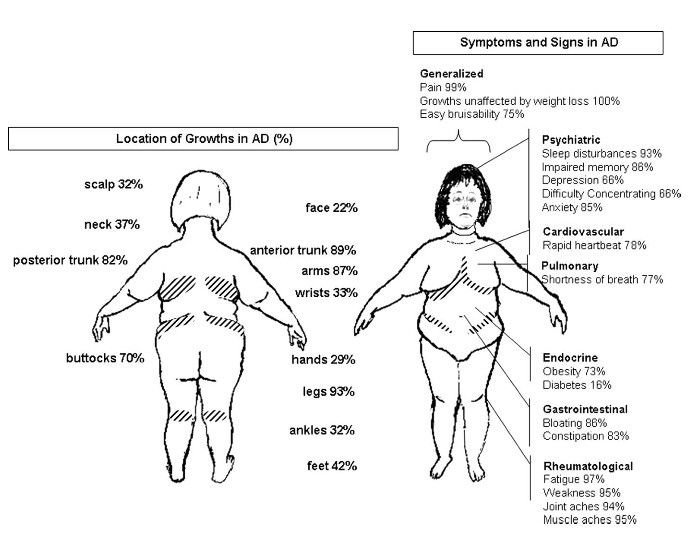
Pain distribution in Dercum’s disease.
Dercum’s disease is similar to fibromyalgia but with the exception of painful lipomas. (1)
The additional disorders in Dercum’s disease are easy bruising, obesity, diabetes, constipation, fatique, muscle weakness, emotional instability and joint pain.
Classification
Dercum’s disease is classified into four stages:
- I Generalised diffuse form – a type of disease with diffusely present painful lipomas
- II Generalized nodular form – a type of disease with the presence of general pain in and in the surrounding tissue of multiple lipomas.
- III Localised nodular form – a type of disease with the present pain in and around the lipomas
- IV Juxtaarticular form – a type of disease with solitary deposits of fatty tissue at the internal parts of the knee.
Ethopathogenesis
Researches have suggested that the nervous system dysfunction may play an important role in the onset of pain in Dercum’s disease. The autonomous nervous system is labeled as the initial trigger of the pain. It is due to the sympathetic nervous efferent fibers, thus in certain cases sympathectomy may be of benefit. (2)
There is another causative factor described such as a local defect in lipid metabolism. It has been shown that fatty acid biosynthesis might be impaired, especially in the production of monounsaturated fatty acids in individuals with Dercum’s disease.
The inflammatory process in Dercum’s disease is characterised by the increased inflammation markers – erythrocyte sedimentation rate and C reactive protein.
Complications Of Dercum’s Disease
There are certain complications that aree indicative of Dercum’s disease such as increased blood clotting, fat emboli, fatty heart, higher incidence of cardiovascular disorders and lymphedema.
Diagnosis Of Dercum’s Disease
Diagnosis is based upon clinical examination and thorough exclusion of possbile differential disorders.
The presence of pain is required for an adequate diagnosis. The pain is present in lipomas and in skin – hyperalgesia. The pain is of migratory character and after several years it may become numb and disabling. In certain cases, arthralgias and myalgias are present.
In individuals with Dercums disease, there is a noted increased oxygen consumption, decreased fatty acid desaturation and reduced glucose conversion to neutral glycosides.
Magnetic resonance imaging shows the lipomas in two planes. Computed tomography is characterized by lower quality of lipoma visualization.
Ultrasound may be a good diagnostic option if guided an experienced healthcare individual. The majority of lesions are seen as <2 cm in maximum diameter and as hyperechogenic. Doppler ultrasound shows no increase in flow.(3)
Treatment Of Dercum’s Disease
There are several treatment modalities of Dercums disease.
The resection of lipomas decreases the intensity of pain, but recidivs and seromas are frequent. The liposuction procedures are of use, thus they imporve an overall quality of life.
The manual lymphatic drainage and pain medication (pregabalin – calcium-channel modulator ) reduces pain and weight loss.
Bariatric surgery shows an improved comorbidities rate and minimal weight loss. The administration of cycling hypobaric pressure improves pain symptoms and mental performance.
The use of infliximab, methotrexate, interferonalpha-2b induces pain relief in hepatiis C individuals.
Pictures
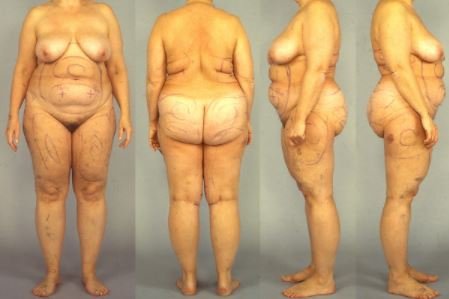
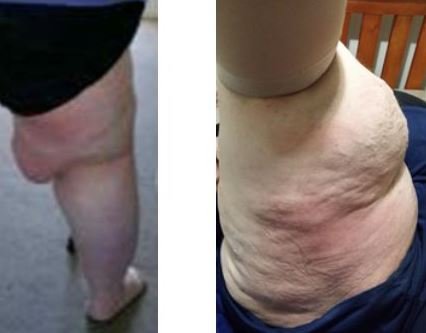
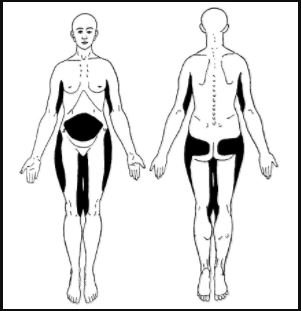
REFERENCES
- Emma Hansson,Review of Dercum’s disease and proposal of diagnostic criteria, diagnostic methods, classification and management. Orphanet J Rare Dis. 2012; 7: 23.
- Nadia Ali Azfar. Case Report Dercum’s disease: a case report. Journal of Pakistan Association of Dermatologists 2010; 20: 103-105.
- Tins BJ. Adiposis dolorosa (Dercum’s disease): MRI and ultrasound appearances. Clin Radiol 2013;25:001992.

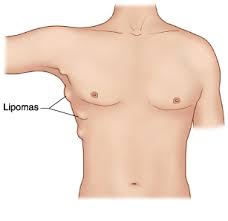
I have had about 6 lypomias removed from my body. The first was 7 &1/2 lbs. on my back. the surgery resulted in huge scaring on my back. I was in the hyperbariac chamber and lots of surgerys on just the area. I just look in the mirror and found 2 very large black spots that seem to be going inward towards my back bones. I am frightened that it is bad news. Can this be associated with Durcums. I have already been diagnost with Durcums 10 years ago.
Does this include granulation in the joints? When I first noticed lipomas I also began to notice a grainy crackling whenever my joints moved. Are the two associated?
I unfortunately have dercums. I have the blackish looking ones here and there. I also have the left knee cap feels grainy and now it gives out on me. I have over 200 of these things. Had 27 removed. Also had a false positive mammogram cause if these lipomas. I had a cluster of lipomas which was not cancerous removed from my breast. I am trying to find a dr. Whom knows about this disease no luck. Poughkeepsie n.y
I have Dercum also. I live in Boston, ma and go to Mass General Hospital in Boston,ma Dr. Allison Vram Dermotology. I went to many specialists until I found her.
Hello Ms. Quiles,
my name is Dr. Daniel Stein. I am a lipid (fat metabolism) expert and I work at Montefiore Medical Center. We are starting a research study of patients like yourself with Dercum’s or Madelung Disease (Multiple Lipomatosis).
If you are interested in more information, my contact information is as follows:
Daniel T. Stein, MD
Professor of Medicine
Division of Endocrinology and Metabolism
1300 Morris Park Ave
Gm. G02
Bronx, NY 10461
Office: 718-430-2446
Fax: 718-430-8998
daniel.stein@einsteinmed.org
I am 67 yo female with fibromyalgia and multiple various sized lipomas. I know when they start to develop because of pain that begins in the area. I have a large one on my back close to my right shoulder blade. It has become to cause much pain and a doctor hated to try to remove it because of fibro and the extra pain it causes. I worry that if it grows much more it will be more difficult to remove and even more painful and more unsafe to remove. Told it is possible Dercum’s. I also have arthritis and bone spurs around spine and other parts of my body. Have had rotator cuff repair, neck fusion and waiting on knee replacement. I could write a book on myself – much from my Mom who died at 79.
I began a few small lipoma’s several yrs. ago with one on my lower right shoulder growing and causing a lot of pain. A surgeon scheduled MRI and said it was larger under the skin but due to me having fibromyalgia and in my 60’s he didn’t want to remove it at the time. I have talked to him again due to increased pain and the enlargement of the lipoma and he wants to do a more current MRI and discuss removal. However, I’ve heard of and read about Dercum’s and my symptoms are the same with several limpomas popping up throughout my body and causing lost of pain. They are small but I can actually feel it when ones is developing before I even feel it. There will be pain in the area and I will rub it and find a small knot which grows slowly. I am overweight now and hurt so badly with arthritis, fibro, and possibly Dercum’s. What type of doctor do I need to see? I am long time retired and divorced (with no children or help) and have always been very independent but my quality of life has been all but gone for several yrs. Thank you so much for you assistance.